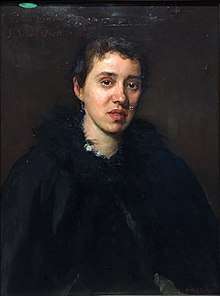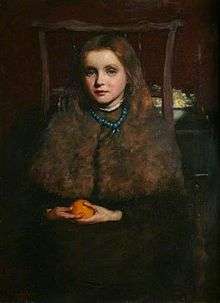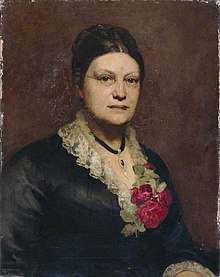Susan Isabel Dacre
Susan Isabel Dacre (1844–1933), known as Isabel Dacre,[1] was an English artist of the Victorian era.[2]
Susan Isabel Dacre | |
|---|---|
 Portrait of Susan Isabel Dacre by Annie Swynnerton (1880). Manchester Art Gallery | |
| Born | 1844 Leamington, Warwickshire |
| Died | 1933 (aged 88–89) |
| Nationality | British |
| Education | Manchester School of Art, Académie Julian |
Biography
She was born in Leamington, Warwickshire, and was educated at a convent school in Salford. For the decade of 1858–68 she lived in Paris, first attending school and later working as a governess. After a winter in Italy (1869), she returned to Paris, and was present during the Franco-Prussian War and the Paris Commune. She returned to England in 1871 and began studying art at the Manchester School of Art, where she won the Queen's Prize in 1875. She began a lifelong friendship with fellow artist Annie Swynnerton; the two women pursued their art studies in Rome and Paris between 1874 and 1880.[3]
Around 1872, Lord Leighton dictated notes and observations on his methods of painting and composing his pictures to Isabel Dacre, during a stay on the island of Capri.
Portraits and the Académie Julian


From 1877–80 she was in Paris at the Académie Julian with a fellow - pupil Marie Bashkirtseff and bracketed with her as first in the concourse mentioned in the famous diary.
Dacre was associated with Julian's atelier on two occasions:
1878–79 when she completed a striking black and white chalk drawing, Portrait of a Young Girl in a Satin Cap, ca. 1879, which is owned by the Andre Del Debbio Collection, Paris.
Later she accomplished several works that gained her entry to the Paris Salon. For example, her Salon entry in 1881 was a portrait: Portrait of Mme. F.W. (no 579.) [4] Manchester Art Gallery own a poignant oil painting Italian Women In Church. Throughout her career her portraits were admired in Italy, England and Paris.
After living in London for a time she returned to Manchester in 1883 and shared a studio in 10 King Street with the artist Mary Florence Monkhouse. After much campaigning by both Dacre and Monkhouse in 1897 Dacre was made a member of the council of the Manchester Academy of Fine Arts and Monkhouse was appointed auditor.
At the Royal Jubilee Exhibition, Manchester 1887 she had her work on display, and assisted Ford Madox Brown with the decoration of the exhibition's dome.[5]
Feminist and Suffragette
Dacre was a noted feminist and suffragette.[6] With Annie Swynnerton she founded the Manchester Society of Women Artists in 1876; Dacre also served as president of the organization. For a decade (1885–95), Dacre was a member of the executive committee of the Manchester National Society for Women's Suffrage.
Dacre's portrait of feminist editor Lydia Becker is one of her best-known works.[7]
References
- "S. Isabel Dacre". Manchester Art Gallery. Retrieved 12 August 2012.
- Deborah Cherry, Painting Women: Victorian Women Artists, London, Routledge, 1993.
- Brian Stewart & Mervyn Cutten (1997). The Dictionary of Portrait Painters in Britain up to 1920. Antique Collectors' Club. ISBN 1 85149 173 2.
- Gabriel P Weisberg and Jane Becker, Overcoming All Obstacles The Women Of The Academie Julian, NJ, Rutgers University Press, 1999, Gabriel P Weisberg, pp. 24–25.
- Susan W Thomson, MVAS Manchester Art Press, 2007, Chapter 13 – Victorian Female Artists Making Their Mark On Manchester’s Art Scene, pp.193–202.
- Elizabeth Crawford, The Women's Suffrage Movement, London, Routledge, 2001; pp. 156-7.
- Carol David, "Investitures of Power: Portraits of Professional Women," Technical Communication Quarterly, Vol. 10 No. 1 (January 2001), pp. 5-29.
Bibliography
Susan W Thomson, Manchester’s Victorian Art Scene And Its Unrecognised Artists, Manchester Art Press, 2007. ISBN 978-0-9554619-0-3
External links
| Wikimedia Commons has media related to Susan Isabel Dacre. |
- 22 paintings by or after Susan Isabel Dacre at the Art UK site: works in UK public collections.